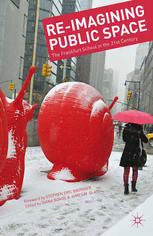
Re-Imagining Public Space: The Frankfurt School in the 21st Century PDF
Preview Re-Imagining Public Space: The Frankfurt School in the 21st Century
RE-IMAGINING PUBLIC SPACE This page intentionally left blank RE-IMAGINING PUBLIC SPACE THE FRANKFURT SCHOOL IN THE 21ST CENTURY Edited by Diana Boros and James M. Glass Foreword by Stephen Eric Bronner RE-IMAGINING PUBLIC SPACE Copyright © Diana Boros and James M. Glass, 2014. Softcover reprint of the hardcover 1st edition 2014 978-1-137-38343-3 All rights reserved. First published in 2014 by PALGRAVE MACMILLAN® in the United States— a division of St. Martin’s Press LLC, 175 Fifth Avenue, New York, NY 10010. Where this book is distributed in the UK, Europe and the rest of the world, this is by Palgrave Macmillan, a division of Macmillan Publishers Limited, registered in England, company number 785998, of Houndmills, Basingstoke, Hampshire RG21 6XS. Palgrave Macmillan is the global academic imprint of the above companies and has companies and representatives throughout the world. Palgrave® and Macmillan® are registered trademarks in the United States, the United Kingdom, Europe and other countries. ISBN 978-1-349-48052-4 ISBN 978-1-137-37331-1 (eBook) DOI 10.1057/9781137373311 Library of Congress Cataloging-in-Publication Data Re-imagining public space : the Frankfurt School in the 21st century / edited by Diana Boros & James Glass ; foreword by Stephen Eric Bronner. pages cm Includes bibliographical references and index. 1. Public spaces—Political aspects. 2. Frankfurt school of sociology. 3. Critical theory. 4. Political sociology. I. Boros, Diana, 1980– II. Glass, James M. HT185.R45 2014 306.2—dc23 2014023287 A catalogue record of the book is available from the British Library. Design by Newgen Knowledge Works (P) Ltd., Chennai, India. First edition: December 2014 10 9 8 7 6 5 4 3 2 1 CONTENTS List of Figures vii Foreword ix Stephen Eric Bronner Rutgers University Introduction 1 Diana Boros and James M. Glass St. Mary’s College of Maryland and University of Maryland 1. Habermas, the Public Sphere, and Democracy 19 Douglas Kellner University of California, Los Angeles 2. Reflections on the Meaning and Experience of Public Space: A Critical Psychoanalytic Perspective 45 Michael A. Diamond University of Missouri 3. The Public Sphere as Site of Emancipation and Enlightenment: A Discourse Theoretic Critique of Digital Communication 65 David Ingram and Asaf Bar-Tura Loyola University of Chicago 4. Walter Benjamin and the Modern Parisian Cityscape 87 Mary Caputi California State University, Long Beach 5. Critical Spaces: Public Spaces, the Culture Industry, Critical Theory, and Urbanism 107 Malcolm Miles Plymouth University 6. Idealizing Public Space: Arendt, Wolin, and the Frankfurt School 125 C. Fred Alford University of Maryland, College Park vi CONTENTS 7. Spatial Form and the Pathologies of Public Reason: Toward a Critical Theory of Space 141 Michael J. Thompson William Paterson University 8. Adorno and the Global Public Sphere: Rethinking Globalization and the Cosmopolitan Condition of Politics 163 Lars Rensmann John Cabot University 9. The Carnivalization of the Public Sphere 191 Lauren Langman Loyola University of Chicago 10. # OccupyTheEstablishment: The Commodification of a “New Sensibility” for Public Space and Public Life 215 Diana Boros and Haley Smith St. Mary’s College of Maryland and University of British Columbia Index 241 FIGURES 2.1 The psychodynamics of public space 54 7.1 Nesting of socioepistemic frames 152 7.2 Model of the effect of sociospatial structure on normative and cognitive capacities 154 This page intentionally left blank FOREWORD Critical theory was once the province of a small circle of intellectuals. Not anymore. It has invaded all the social sciences and the humani- ties. What had begun in 1929 as an extra-academic form of interdisci- plinary investigation, committed to an assault upon “traditional” theory in its metaphysical and materialist forms, has been captured by existing disciplines and, for the most part, domesticated. Stars of the “Frankfurt School” such as Theodor W. Adorno, Walter Benjamin, Jürgen Habermas, and Herbert Marcuse are now part of the canon. In the process, however, their books have turned into classical texts subject (like all others) to the deadening demands of academic exegesis and purely esoteric debate. Critical Theory has become just another philosophical approach, and as a consequence it has undergone a crisis of purpose. Its connection to a transformative project has been sundered, its radical bite has been lost, and its commitment to liberation has virtually disappeared. New devel- opments call for subjecting current understandings of Critical Theory to its own form of critique. In this regard, Re-Imagining Public Space: The Frankfurt School in the 21st Century has important contributions to make. Diana Boros and James M. Glass, the editors, have put together a vol- ume that attempts to reclaim the past in order to confront the present and project new possibilities for the future. Their anthology is comprised of essays written by authors who have gained special prominence in dealing with the critical tradition. I have known many of them for a long time and even collaborated with them; a few were my students who are now following their own paths; and the rest I know from their notable writ- ings. It is a privilege for me to introduce this remarkably well-focused anthology that deals with a basic intellectual concern of mine. Years ago I called for confronting the establishmentarian malaise of Critical Theory by reaffirming its political and public character. This anthology takes an important step in that direction. Critical Theory is here, once again, treated as a social theory. The difference with early works like Gaston Bachelard’s The Poetics of Space (1964) could not be clearer. Narrow aes- thetic, geographic, and philosophical concerns make way for viewing
